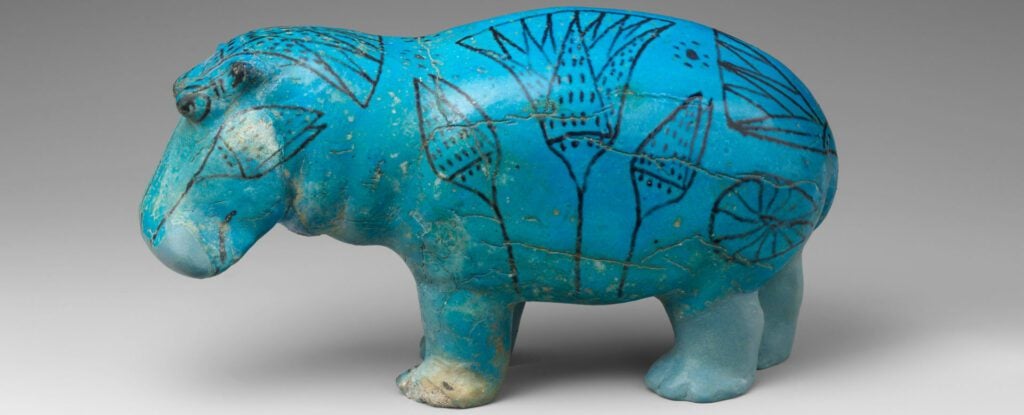A famous statuette in Ancient Egyptian art was the blue faience hippopotamus. It was thought to have positive qualities associated with fertility and rebirth by the Ancient Egyptians. Little hippopotamus statuettes were also discovered among the objects buried in tombs. They are now found worldwide, ranging in length from 9 to 23 centimeters. But did you know the story behind these little statutes?
Approximately 50-60 blue faience hippopotamus statuettes from Ancient Egypt have survived. Because of the danger hippos posed in the wild, they frequently snapped off the legs of hippopotamus statuettes before placing them in tombs so that the hippos couldn’t eat the deceased’s soul.
The Blue Hippo Statuettes at MET Museum
William is so well-liked by visitors to The Met, where he has resided since 1917, that he has become the museum’s mascot. He was one of two discovered in a shaft near the tomb chapel of the steward Senbi II at Meir, an Upper Egyptian site. Three legs have been repaired after being purposefully broken to keep the creature from harming the deceased.
This small Egyptian Middle Kingdom hippopotamus statuette is known as William. The figurine was created during the 12th Dynasty and was found in a tomb with another. The bright, blue faience hippopotamus is only 11.2cm tall and 20cm long, with a well-rounded body and stumpy legs. The eyes have been enhanced with black paint, and the body has been decorated with vegetal motifs representing regeneration, open and closed lotus flowers, buds, and leaves. (Source: World Archeology)
When and Where was the Hippo Discovered?
Sayyid Pasha Khashaba discovered the statuette in May 1910. It is one of two found in the nomarch Senbi II’s burial chamber at Meir. The figure was purchased by the Metropolitan Museum of Art in New York in 1917 and is still on display. Captain H M Raleigh first dubbed it William, writing in the satirical British magazine Punch in March 1931 that he and his family have an oracular color print of the hippopotamus that they love and revere, with an intensity bordering on the pagan, and that has the casting vote in all family disputes, and orders our goings out and comings in.
The story of William the oracle was well received; the Met published it in their Bulletin the following year, and William quickly became the museum’s unofficial mascot. He is still a popular attraction today. (Source: World Archeology)
Rebirthed as Hippos
Hippopotamus figurines are frequently discovered in Middle Kingdom tombs. It was thought they could aid in the rebirth of the deceased; a role alluded to by William’s blue glaze and lotus flowers painted on him. These evoke his natural habitat of the Nile marshes, the great river essential to life in ancient Egypt. The decorative lotuses carry on the association, as the cycle of the lotus flower opening at sunrise and closing at sunset was closely linked with the process of birth, death, and rebirth.
However, there was a way to deal with this animal’s negative characteristics. Only one of William’s original legs remains, the front left, and the other three are modern restorations. The legs were believed to be deliberately broken to reduce the threat this dangerous creature posed to the deceased’s well-being. (Source: World Archeology)
Image from MetMuseum.Org
